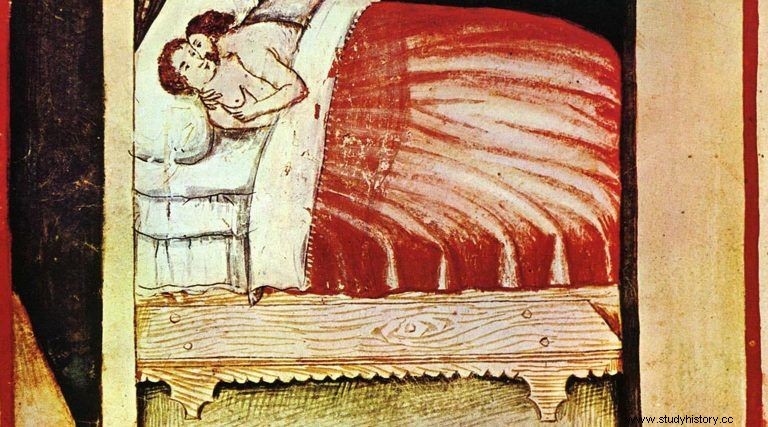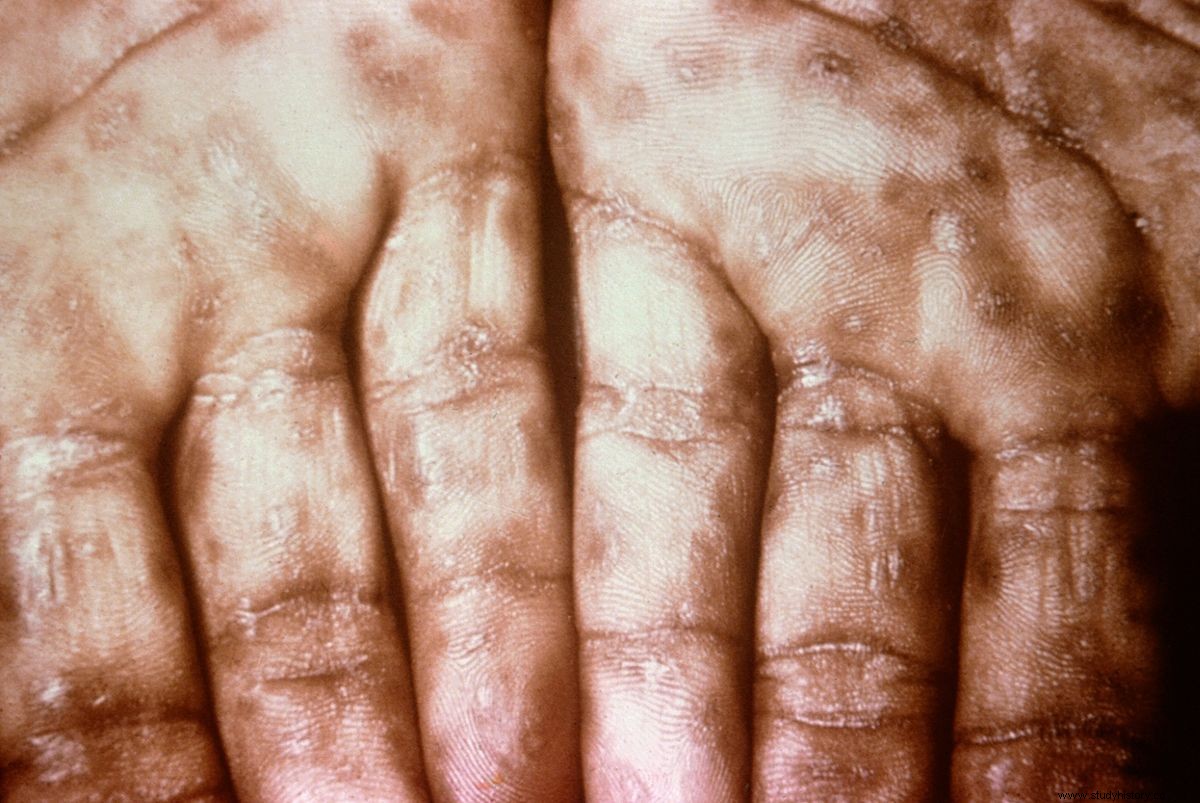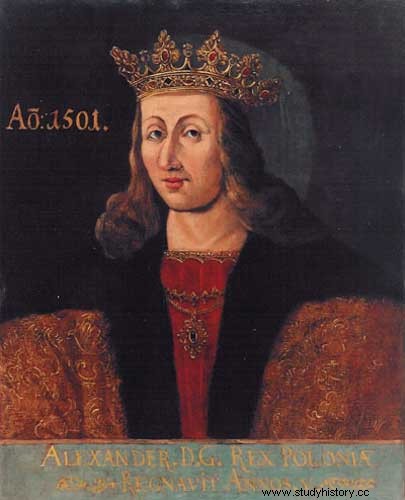The curse of Venus did not spare anyone. It caught the townspeople, peasants and nobles justly. At least a few Polish rulers suffered from syphilis. Was Aleksander Jagiellończyk among them? After all, unlike his older brother, he was not famous for his debauched lifestyle. On the contrary! So what was he hiding?
In May 1494, the south of Europe was shaken by a new armed conflict - the so-called Italian wars. The army of King Charles VIII of France went from victory to victory. The fame of bronze cannons, against which no walls at that time protected, meant that more cities fell into French hands. Among them was Naples, where the royal army spent eighty long days - days full of plunder, feasts and all kinds of debauchery. As it soon turned out, the city was not the only gain of Charles' soldiers ...
Soon after, a mysterious disease began to spread among the mercenaries. The disease was initially associated with leprosy, but due to its rather rapid course, this hypothesis was rejected with time. The first symptom was lymphadenopathy in the groin and the appearance of hard lumps on the genitals. Unaware patients complained of insomnia, depression, and pain in arms and legs.
But the worst was ahead of them - after a while, there was an itchy rash that turned into foul-smelling ulcers. The bodies of the unfortunates began to rot; their ears, noses, and hands fell off. They ended their lives with attacks of apoplexy and paralysis, accompanied by unrestrained diarrhea.
Discoveries not necessarily geographical
The sources of this - it would seem - satanic disease were sought in unfavorable star systems or on ... Columbus ships. The discoverers of the New World were to bring the plague known to the natives to Spanish ports, from where the local daughters of Corinth passed the disease on to the later conquerors of Naples (a large part of Charles VIII's army were Spaniards).

One of the theories of the origin of the disease blamed the human being returning from trips to the New World.
Initially, the symptoms were not associated with the sexual act, and since the mercenaries of the French monarch did not suddenly become models of sexual abstinence after going home , the road to the European pandemic was open . The medicine of that time was actually helpless in the face of an extremely virulent "new plague." All she could recommend were prayers to St. Dionysius, escapes to the forest, isolating the infected and burning ulcers with red-hot iron.
Interestingly, the new disease was considered to be something much more dangerous than the well-known leprosy, and the lepers themselves strongly protested against placing patients suffering from this strange disease in leprosy.
In search of those to blame
In "pious" Europe, the "Naples", as the mysterious ailment came to be called, was spreading like wildfire. Everyone blamed everyone for bringing it - most often their enemies. And so in the German Reich, England and Italy it is called the French disease, in France - the Spanish disease. On the other hand, Poles believed that it was a German affliction, and in Moscow there was a widespread belief in her Polish origin. The Turks believed that the plague came from the Christians, and in Japan it came from the Chinese. Consensus was only achieved with the help of the poet and physician Girolamo Fracastoro.
In 1530 he published a didactic poem " About syphilis or French disease "Telling the story of a swineherd with the graceful name of Syphilis, whom the sun god Apollo punished with this very ailment.
From Italy to Poland
The prevalence of the disease also became a family problem of the Jagiellonian dynasty. The first recorded case of syphilis appeared in Poland in 1495, and two years later Jan Olbracht began to complain about its symptoms. The king was to receive this embarrassing gift through a certain wife of a shoemaker who returned from an indulgence in Rome (!). However, while the emergence of embarrassing symptoms in this particular monarch, who "indulged in his passions and lusts as a military man ", No one was surprised, his successor (and younger brother) was by no means expected.

One symptom of the disease is an itchy rash that has progressed to foul-smelling ulcers.
Especially since, according to the messages, Alexander seemed to be an example of health. However, appearances were deceptive, as it was found out at the beginning of June 1505. It was then that the "muscular, endowed king" suffered multiple attacks of apoplexy and as a result suffered paralysis of the left side of his body.
The feverish efforts of the doctors allowed the monarch to free himself from helplessness - he could even ride a horse. However, less than a year later, after an exhausting trip to Lithuania, Alexander's health deteriorated again. This time the royal medics were helpless, looking for the sources of the ruler's health problems in the tendency of his body to paralysis, the plague air or the strange creation that combined both causes - paralytic air (!).
Last resort
Feeling worse and worse, the Jagiellonian decided - contrary to the opinion of the court physician, Maciej of Błonie - to call the famous doctor Aleksander Baliński at that time. It is not really known whether this savior actually graduated from medical school. Yet he was in fact a miracle worker "to whom all the sick Kingdom converged to be healed." Patients were not even discouraged by the high fee of 100 ducats, and in the case of the king, even three times that amount.
Upon his arrival, the doctor recommended that "in one of the rooms of the Vilnius castle be prepared a hot bath, to which he put a variety of herbs strong in pots, the other he put in a pot, and put on top of the king's steam, having seasoned a place for him to sweat". He did not stop there - he also ordered Aleksander to drink Malmasja and other stronger wines.

Paralyzed Aleksander Jagiellończyk died on August 19, 1506 at the age of 45. It is now believed that the king just died of syphilis.
The king was eager to follow the instructions, but his condition did not improve, and it was even worse. At first the Jagiellonian lost consciousness again and again, and then his life became uncomfortable with persistent diarrhea. As if that was not enough, the tormented monarch suffered from insomnia and only "among the pillows alone could he pant". All this did not seem to put off Baliński, however, who continued to torture his crowned patient with consistency.
Finally, seeing that the treatment of the famous doctor made Aleksander "desperate", the restored Maciej of Błonie asked Chancellor Łaski to snatch the ruler from the hands of the pseudo-medic. Baliński was arrested, but it was too late to save Aleksander . The monarch, after stopping the infusions and consuming amounts of wine unusual for him, felt better, but no one had any hope for his recovery.
The paralyzed Jagiellonian died on August 19, 1506 at the age of 45. Today it is believed that the king - today, despite his merits for Poland, is almost completely forgotten - died of syphilis. At that time, however, it was not even suspected. After all, although he was childless, his relationship with Helena, a Ruthenian princess, was considered extremely harmonious and happy. The messages unanimously emphasize the fidelity of the spouses. So where is the place for the Neapolitan ailment here? Alexander took this secret with him to the grave…
Bibliography:
- Jankowski J., Monarchy secrets , Wrocław 1995.
- Jasienica P., Jagiellonian Poland, Warsaw 2018.
- The Polish Chronicle of Marcin Bielski redesigned by Ioach. Bielski's son released…, Krakow 1597.
- Kulikowski J., The doctor of Aleksander Jagiellończyk , https://www.polityka.pl/tygodnikpolityka/historia/1501201,1,lekarz-aleksandra-jagiellonczyka.read [access:August 26, 2020].
- Maciorowski M., Maciejewska B., Rulers of Poland. History re-told , Warsaw 2018.
- Papée F., Aleksander Jagiellończyk , Warsaw 1949.
- Stomma L., Sexual life of Polish kings and other delicacies , Warsaw 2002.
